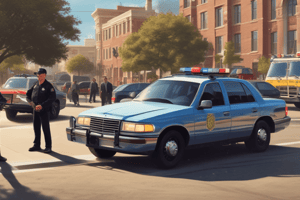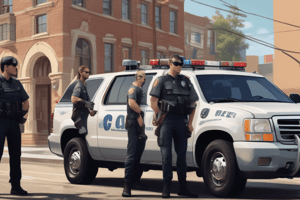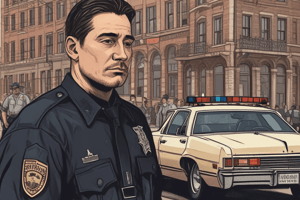Podcast
Questions and Answers
What is considered the main yardstick of police efficiency in the modern concept of policing?
What is considered the main yardstick of police efficiency in the modern concept of policing?
- The absence of crime (correct)
- The number of arrests made
- The amount of property recovered
- The presence of police officers in the community
Which function of the police is primarily aimed at reducing the desire to commit crime?
Which function of the police is primarily aimed at reducing the desire to commit crime?
- Administrative Functions
- Crime Control
- Regulation of Non-Criminal Conduct
- Crime Prevention (correct)
Which of the following is NOT one of the primary objectives of the police?
Which of the following is NOT one of the primary objectives of the police?
- To protect lives and limbs
- To protect properties of the citizenry
- To create job opportunities (correct)
- To maintain order in the community
What type of police functions involve activities such as patrol work and traffic management?
What type of police functions involve activities such as patrol work and traffic management?
In police operations, which function includes tasks like budgeting and public relations?
In police operations, which function includes tasks like budgeting and public relations?
Which statement reflects the concept of organization in the context of police work?
Which statement reflects the concept of organization in the context of police work?
Which of the following best describes the crime control function of the police?
Which of the following best describes the crime control function of the police?
Which aspect of police functions deals with transportation and communication support?
Which aspect of police functions deals with transportation and communication support?
What is the primary activity of law enforcement agencies?
What is the primary activity of law enforcement agencies?
Which of the following theories treats police officers as servants of higher authorities?
Which of the following theories treats police officers as servants of higher authorities?
The modern usage of the word 'police' relates to which of the following?
The modern usage of the word 'police' relates to which of the following?
Which concept classifies police as merely repressive machinery?
Which concept classifies police as merely repressive machinery?
In which type of governmental structure are policemen viewed as servants of the community?
In which type of governmental structure are policemen viewed as servants of the community?
The word 'police' originally derives from which Greek word?
The word 'police' originally derives from which Greek word?
What was the primary purpose of the Marine Police established in 1798?
What was the primary purpose of the Marine Police established in 1798?
Which of the following best describes police functions in the Continental Theory?
Which of the following best describes police functions in the Continental Theory?
What is the smallest functional group within a police organization?
What is the smallest functional group within a police organization?
Which of the following describes an operational unit in a police organization?
Which of the following describes an operational unit in a police organization?
What do we call the primary subdivision of a bureau within a police organization?
What do we call the primary subdivision of a bureau within a police organization?
Which of these best describes a 'post' in a police organization?
Which of these best describes a 'post' in a police organization?
Which functional units are responsible for administrative functions within a police organization?
Which functional units are responsible for administrative functions within a police organization?
What is the characteristic feature of a Line/Military organizational structure?
What is the characteristic feature of a Line/Military organizational structure?
In a Line and Staff organizational structure, what role do the staff members serve?
In a Line and Staff organizational structure, what role do the staff members serve?
What does the term 'Span of Control' refer to in organizational principles?
What does the term 'Span of Control' refer to in organizational principles?
Which organizational structure involves divisions based on specialized functions?
Which organizational structure involves divisions based on specialized functions?
What is the primary purpose of delineation of responsibility in an organization?
What is the primary purpose of delineation of responsibility in an organization?
Which of the following best describes the Line and Staff structure?
Which of the following best describes the Line and Staff structure?
What is a drawback of a Functional structure in an organization?
What is a drawback of a Functional structure in an organization?
Which principle of organization emphasizes dividing work logically among various units?
Which principle of organization emphasizes dividing work logically among various units?
What does the principle of Unity of Command emphasize in an organizational structure?
What does the principle of Unity of Command emphasize in an organizational structure?
Which principle ensures that no individual manager's authority should be larger than their delegated responsibility?
Which principle ensures that no individual manager's authority should be larger than their delegated responsibility?
What is the focus of the Command Responsibility principle in an organization?
What is the focus of the Command Responsibility principle in an organization?
Which principle relates to the clear delegation of authority necessary to achieve expected results?
Which principle relates to the clear delegation of authority necessary to achieve expected results?
What does the Authority-Level Principle promote within an organizational structure?
What does the Authority-Level Principle promote within an organizational structure?
Which principle supports the need for coordination and integration among different units in an organization?
Which principle supports the need for coordination and integration among different units in an organization?
What does the Principle of Flexibility suggest about an organizational structure?
What does the Principle of Flexibility suggest about an organizational structure?
The Principle of Hierarchy dictates which aspect of organizational structure?
The Principle of Hierarchy dictates which aspect of organizational structure?
Study Notes
Law Enforcement Overview
- Law enforcement is organized government activity to enforce laws, discover and deter crime, and rehabilitate or punish offenders.
- The police play a central role in preventing crime and maintaining peace and order, termed law enforcement.
Etymology of "Police"
- Originates from the Greek word "Politeia," indicating a government of a city.
- Romans adapted it to "Politia," and Middle French modified it to "Porice," meaning public order guaranteed by the state.
- The term "police" was recorded in English in 1798 with the establishment of the Marine Police in London.
Fundamental Theories of Police Service
-
Continental Theory:
- Officers are viewed as servants of higher authorities; public involvement is minimal.
- Prevalent in centralized countries like France and Spain.
-
Home Rule Theory:
- Officers are community servants focused on public safety.
- Common in decentralized systems such as the USA and England.
Concepts of Police Service
-
Old Concept:
- Police function as a repressive force with an emphasis on arrests.
-
Modern Concept:
- Focuses on crime prevention and community welfare, measuring effectiveness by the absence of crime.
Police Objectives
- Protect community members' lives and limbs.
- Maintain order within the community.
- Safeguard citizens' properties.
- Assist other governmental agencies as needed.
Basic Police Functions
-
Crime Prevention:
- Aims to eliminate or reduce criminal desires, working closely with justice and social agencies.
-
Crime Control:
- Focuses on neutralizing criminal activities, emphasizing law enforcement and adherence to penal codes.
-
Regulation of Non-Criminal Conduct:
- Enforces rules and regulations to achieve societal standards of behavior.
General Categories of Police Activities
-
Line or Operational Functions:
- Include patrol, traffic management, criminal investigations, and control of juvenile and vice offenses.
-
Auxiliary or Service Functions:
- Comprised of transportation, communication, records management, and maintenance of custody facilities.
-
Administrative or Managerial Functions:
- Focus on planning, budgeting, training, and public relations to support operational functions.
Organization and Administration in Law Enforcement
- Concept of Organization:
- A coordinated social entity structured to achieve defined goals with clear authority and leadership.
Organizational Structures
-
Line/Military Structure:
- Clear authority and communication flow from top to bottom; simple hierarchy.
-
Line and Staff Structure:
- Combines direct operational lines with staff providing specialized advice and assistance.
-
Functional Structure:
- Authority is delegated functionally, with oversight divided among specialized units.
Principles of Organization in Law Enforcement
-
Division of Work:
- Logical distribution of tasks among units.
-
Delineation of Responsibility:
- Clear lines of authority to fix responsibilities and avoid duplication.
-
Span of Control:
- Refers to the number of subordinates a supervisor can efficiently manage.
-
Unity of Command:
- Every employee should report to one superior for clear accountability.
-
Chain of Command:
- Establishment of hierarchical relationships that dictate authority and task execution.
-
Delegation of Authority:
- Higher authorities can assign tasks to lower levels, maintaining accountability.
-
Integration and Coordination:
- All units work harmoniously towards shared objectives.
Organic Units in Police Organization
-
Operational Units:
- Responsible for primary functions like patrol and investigations.
-
Administrative Units:
- Handle functions such as human resources, finance, and planning.
-
Service Units:
- Focus on supporting functions like communication and records management.
Functional Units in Police Organization
- Bureau: Largest functional unit comprising various divisions.
- Division: Subdivision within a bureau focused on specific areas.
- Section: Further specialization within a division.
- Unit: Smallest functional group, ensuring task-specific specialization.
Geographical/Territorial Units in a Police Organization
- Post: Specific location assigned to an officer.
- Route: Designated length of streets for patrol.
- Beat: Area assigned for foot or vehicle patrol.
- Sector: Area comprising multiple beats or routes.
- District: Geographical city subdivision for patrol, often with its own station.
- Area: Larger sections consisting of designated districts within a city.
Studying That Suits You
Use AI to generate personalized quizzes and flashcards to suit your learning preferences.
Related Documents
Description
This quiz explores the foundational concepts of law enforcement as introduced in Chapter 1 of the Law Enforcement Organization and Administration text. It covers the roles and responsibilities of government agencies in enforcing laws, crime prevention, and maintaining public order. Perfect for students studying criminal justice and law enforcement principles.




